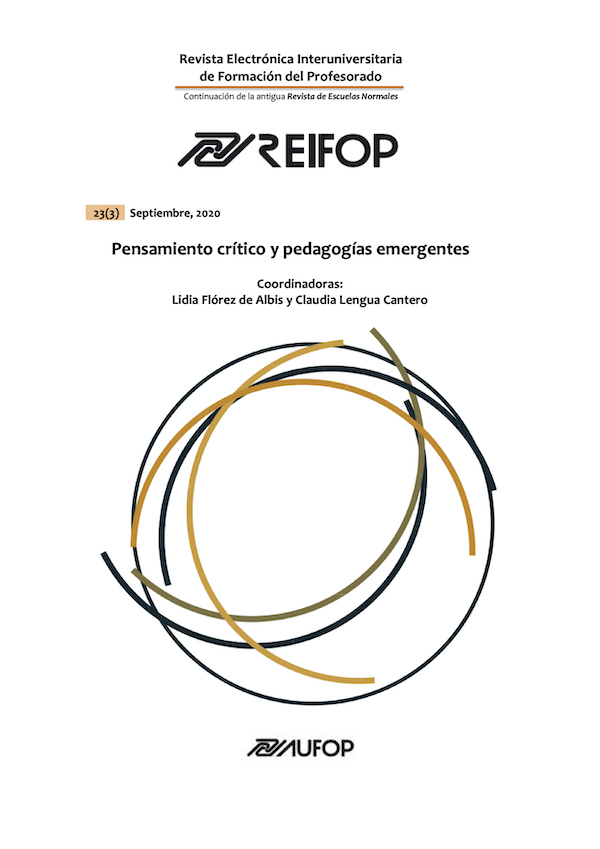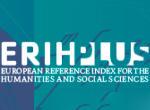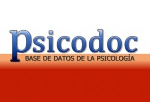Influence of space orientation on perceived exertion in Physical Education: Cooperation-opposition motor games
Abstract
The World Health Organization (WHO, 2010) stablishes a minimum physical practice of 60 minutes per day in a range of moderate to vigorous intensity. Participantes were 28 students of 6th Primary Education. Three cooperation-opposition motor games were developed, varying the space orientation. The objectives were to know the adequacy of perceived effort in the three games, in relation to intensity, to achieve health benefits and compare the perceived effort based on the different space orientations. After the completion of each game, the Pictorical Children's Effort Rating Table (PCERT) were distribuited. Results show students do not reach a sufficient intensity in motor games to obtain health benefits, as well as statistically significant differences for the perceived exertion depending on the space orientation, being the game with higher levels the one that presents oriented space with small goals and the game with lower levels is the non-oriented space game.
Downloads
References
Albarracín, A., Moreno, J. A., y Beltrán, V. J. (2014). La situación actual de la educación física según su profesorado: Un estudio cualitativo con profesores de la Región de Murcia. CCD. Cultura, Ciencia y Deporte, 9(27), 225-234.
Baena, A., y Ruiz, P. J. (2016). El juego motor como actividad física organizada en la enseñanza y la recreación. EmásF: revista digital de educación física, (38), 73-86.
Bayer, C. (1992). La enseñanza de los juegos deportivos colectivos. Barcelona, España: H. E.
Blair, S. N. (2009). Physical inactivity: the biggest public health problem of the 21st century. British Journal of Sports Medidice, 43(1), 1-2.
Biddle, S. J. H., Sallis, J. F., & Cavill, N. (1998).Young and active? Young people and health-enhancing physical activity: Evidence and implications. Londres: Health Education Authority.
Casamichana, D., Castellano, J., González-Morán, A., García-Cueto, H.,y García-López, J. (2011). Demanda fisiológica en juegos reducidos de fútbol con diferente orientación del espacio. RICYDE. Revista Internacional de Ciencias del Deporte, 7(23), 141-154.
Coquart, J., Legrand, R., Robin, S., Duhamel, A., Matran, R. y Garcin, M. (2009). Influence of successive bouts of fatiguing exercise on perceptual and physiological markers during an incremental exercise test. Psychophysiology. 46(1), 209–216.
De Hoyo, M. y Sañudo, B. (2004). Composición corporal y actividad física como parámetros desalud en niños de una población rural de Sevilla.Revista Internacional de Ciencias del Deporte, 3(6), 52-62.
De la Vega, R. (2002). Desarrollo del metaconocimiento táctico y comprensión del juego: Un enfoque constructivista aplicado al fútbol (Tesis Doctoral). Universidad Autónoma de Madrid, Madrid, España.
Gambau, V. (2015). Las problemáticas actuales de la educación física y el deporte escolar en España. Revista Española de Educación Física y Deportes, (411), 53-69.
González, I. M., Fraguela, R., y Varela, L. (2017). Niveles de actividad física en Educación Infantil y su relación con la salud. Implicaciones didácticas. Sportis: Revista Técnico-Científica del Deporte Escolar, Educación Física y Psicomotricidad, 3(2), 358-374.
González-Arévalo, C., y Lleixà-Arribas, T. (2014). Didáctica de la Educación Física. Barcelona: GRAÓ.
Garrido, A. L. (2014). La práctica de actividad física y hábitos de salud de los futuros maestros de Educación Primaria de la Universidad de Barcelona. Un estudio sobre la incidencia de la Educación Física vivida en la ESO en su futura acción docente. (Tesis doctoral). Universidad de Barcelona, España.
Hernández-Álvarez, J. L., del-Campo-Vecino, J., Martínez-de-Haro, V & Moya-Morales, J. M. (2010). Perception of exertion in physical education and its relationship to guidelines on physical activity. Revista Internacional de Medicina y Ciencias de la Actividad Física y el Deporte, 10(40), 609-619.
Kang, J., Hoffman, J. R., Walker, H., Chaloupka, E. C. y Utter, A. C. (2003). Regulating intensity using perceived exertion during extended exercise periods. European Journal of Applied Physiology, 89(5), 475-482.
Lago, C. (2002). La enseñanza del fútbol en edad escolar. Sevilla: Wanceulen Editorial Deportiva S. L.
Lambrick, D., Bertelsen, H., Eston, R., Stoner, L., & Faulkner, J. (2016). Prediction of peak oxygen uptake in children using submaximal ratings of perceived exertion during treadmill exercise. European journal of applied physiology, 116(6), 1189-1195.
Lavega, P. (2007). El juego motor y la pedagogía de las conductas motrices. Revista Conexões, 5(1), 27-41.
Lobos L. L., Leyton, B., Kain, J., y Vio, F. (2013). Evaluación de una intervención educativa para la prevención de la obesidad infantil en escuelas básicas de Chile. Nutrición Hospitalaria, 28(4), 1156-1164.
Martínez, H. F. (2007). Interpretación táctica y enseñanza del fútbol. Revista digital: Lecturas: Educación Física y Deporte, (109).
Martínez, J., Contreras, O. R., Lera, A., y Aznar, S. (2012). Niveles de actividad física medido con acelerómetro en alumnos de 3º ciclo de educación primaria: actividad física diaria y sesiones de educación física. Revista de Psicología del Deporte, 21(1), 117-123.
McKenzie, T. L., Marshall, S. J., Sallis, J. F., & Conway, T. L. (2000). Student activity levels, lesson context, and teacher behavior during middle school physical education. Research Quarterly for Exercise and Sport, 71(3), 249-259.
Mallo, J., y Navarro, E. (2008). Physical load imposed on soccer players during small-sided training games. Journal of Sports and Physical Fitness, 48(2), 166-171.
Montil, M, Barriopedro, M. I. y Oliván, J. (2005). El sedentarismo en la infancia. Los niveles de actividad física en niños/as de la Comunidad Autónoma de Madrid. Apunts. Educación Física y Deportes, 4(82), 5-11.
Nader, P. R., & NICHD (2003). Frequency and intensity or activity of third-grade children in physical education. Archives of Pediatrics and Adolescent Medicine, 157(2), 185-190.
Naclerio, F., Barriopedro, I. y Rodríguez, G. (2008). Control de la Intensidad en los Entrenamientos de Fuerza por medio de la Percepción Subjetiva del Esfuerzo. Kronos, 8(14), 59-66.
Ozkan, A. & Kin-Isler, A. (2007). The reliability and validity of regulating exercise intensity by ratings of perceived exertion in step dance sessions. Journal of Strength and Conditioning Research, 21(1), 296–300.
Parlebas, P. (2001). Juegos, deporte y sociedad. Léxico de praxiología motriz. Barcelona: Paidotribo.
Sanchís, I., Calahorro, F., Lara, A. J., Torres, G. (2015). Nivel de actividad física con acelerometría en clases de educación física según el nivel de práctica deportiva en alumnado de primaria. Tándem: Didáctica de la educación física, (49), 59-66.
Sierra, A. (2003). Actividad física y salud en Primaria. El compromiso fisiológico en la clase de Educación Física. Sevilla: Wanceulen Editorial Deportiva S. L.
Simons-Morton, B. G., Taylor, W. C., Snider, S. A., & Huang, I. W. (1993). The physical activity of fifth-grade students during physical education classes. American Journal of Public Health, 83(2), 262-264.
Som, A., Zabala, M., Sánchez, E., Sánchez, C. y Ramírez, J. (2010). Conocimiento sobre frecuencia cardiaca y percepción de la intensidad del esfuerzo en alumnos universitarios de último curso de Ciencias de la Actividad Física y del Deporte. Apunts. Educación Física y Deportes, (101), 66-74.
Stratton, G. (1997). Children´s heart rates during British Physical Education lessons. Journal of Teaching in Physical Education, 16(3), 357-367.
Tuñón, I., y Laíno, F. (2014). Insuficiente actividad física en la infancia: niños, niñas y adolescentes entre 5 y 17 años en la Argentina urbana. En Observatorio de la Deuda Social Argentina (Ed.), Barómetro de la Deuda Social de la Infancia (pp. 1-21). Ciudad Autónoma de Buenos Aires, Argentina: Universidad Católica Argentina.
Utter, A. C., Robertson, R. J., Green, J. M., Suminski, R. R., McAnulty, S. R. & Nieman, D. C. (2004). Validation of the Adult OMNI Scale of perceived exertion for walking/running exercise. Medicine & Science in Sports & Exercise, 36(10), 1776-1780.
Villagrán, S., Rodríguez-Martín, A., Novalbos, J. P., Martínez, J. M., y Lechuga, J. L. (2010). Hábitos y estilos de vida modificables en niños con sobrepeso y obesidad. Nutrición Hospitalaria, 25(5), 823-831.
WHO. World Health Organization. (2010). Global recommendations on physical activity for health. Geneva: World Health Organization.
Yelling, M., Lamb, K. L. & Swaine, I. L. (2002). Validity of a pictorial perceived exertion scale for effort estimation and effort production during stepping exercise in adolescent children. European Physical Education Review, 8(2), 157-175.
Los artículos que se publican en esta revista están sujetos a los siguientes términos:
1. El Departamento de Métodos de Investigación y Diagnóstico en Educación de la Universidad de Murcia (España), junto con el Servicio de Publicaciones de la Universitdad de Murcia (Editum) son los editores de la revista REIFOP y conserva los derechos patrimoniales (copyright) de los artículos publicados, permitiendo la reutilización de las mismos bajo la licencia de uso indicada en el punto 2.
2. Las obras se publican en la edición electrónica de la revista bajo una licencia Creative Commons Reconocimiento-NoComercial-SinObraDerivada 3.0 España (texto legal). Se pueden copiar, usar, difundir, transmitir y exponer públicamente, siempre que: i) se cite la autoría y la fuente original de su publicación (revista, editores y URL de la obra); ii) no se usen para fines comerciales; iii) se mencione la existencia y especificaciones de esta licencia de uso.
3. Condiciones de auto-archivo. Se permite y se anima a los autores a difundir electrónicamente las versiones pre-print (versión antes de ser evaluada) y/o post-print (versión evaluada y aceptada para su publicación) de sus obras antes de su publicación, ya que favorece su circulación y difusión más temprana y con ello un posible aumento en su citación y alcance entre la comunidad académica. Color RoMEO: verde.















